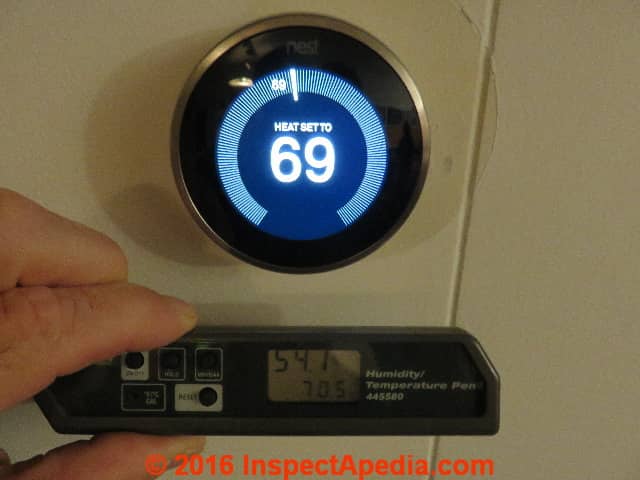Is your Nest thermostat displaying the wrong indoor temperature? This can be frustrating and confusing.
A thermostat’s job is to keep your home comfortable. But when it shows incorrect readings, it can make things difficult. You may wonder if the device is broken or if there is another issue. Understanding why this happens can help you fix it quickly and get back to enjoying a cozy home.
In this blog post, we will explore common reasons for incorrect temperature readings on your Nest thermostat. We’ll also provide simple solutions to resolve this issue. Stay tuned to learn how to ensure your thermostat works properly and keeps your home at the perfect temperature.
Common Causes Of Incorrect Temperature Reading
Many users face issues with their Nest Thermostat showing incorrect indoor temperature. Understanding the common causes can help in resolving these issues. Below, we explore some frequent causes of incorrect temperature readings.
Battery Issues
The Nest Thermostat relies on its battery to function properly. If the battery is low, it can affect the thermostat’s performance. This includes inaccurate temperature readings. Check the battery status in the settings menu.
- Go to Settings
- Select Technical Info
- Check Power
If the voltage is low, replace the battery. A fresh battery ensures the thermostat works accurately.
Sensor Malfunctions
The Nest Thermostat uses sensors to read the indoor temperature. If these sensors malfunction, the temperature reading may be incorrect. Dust and debris can block the sensors.
- Clean the thermostat regularly
- Ensure no objects block the sensors
Sometimes, a sensor may fail completely. In this case, contact customer support for a replacement.
Calibrating Your Nest Thermostat
Calibrating your Nest Thermostat can fix wrong indoor temperature readings. Accurate readings ensure your home stays comfortable and energy-efficient. Follow this guide to calibrate your Nest Thermostat.
Step-by-step Guide
First, open the Nest app on your smartphone. Select your thermostat and go to settings. Look for the option labeled “Technical Info” and tap on it. This will show your thermostat’s current temperature readings.
Next, compare the Nest readings with an accurate thermometer. Place the thermometer near your Nest Thermostat. Allow it to sit for a few minutes to get a stable reading. Note down the temperature shown by both devices.
If the readings differ, you need to recalibrate. Go back to the settings menu in the Nest app. Look for the “Equipment” option and select it. Choose “Continue” and then “Calibrate” to start the process. Follow the on-screen instructions to complete the calibration.
Ensuring Accurate Readings
After calibrating, it is important to verify the accuracy. Check the temperature readings again with your thermometer. Ensure they are close or match. This helps in maintaining a comfortable home environment.
Keep your Nest Thermostat clean. Dust can affect the sensors and lead to wrong readings. Regularly wipe the device with a soft, dry cloth.
Finally, update the Nest app and firmware. Updates often include bug fixes and improvements. This can enhance the accuracy of your thermostat.
Checking Thermostat Placement
A Nest Thermostat showing the wrong indoor temperature can be frustrating. One common cause is poor placement. Correct placement ensures accurate readings, optimizing your home’s comfort and energy efficiency.
Ideal Locations
Placing your Nest Thermostat in the right location is essential. The thermostat should be centrally located in your home. This helps in getting an average temperature reading.
- Eye Level: Install the thermostat at eye level for easy access.
- Central Area: Place it in a central room, like the living room.
- Frequently Used Rooms: Position it in rooms you use often.
Avoiding Heat Sources
Avoid placing the thermostat near heat sources. Heat sources can cause inaccurate readings.
| Heat Source | Impact on Temperature Reading |
|---|---|
| Direct Sunlight | Causes the thermostat to read higher temperatures. |
| Appliances | Generates heat, leading to inaccurate readings. |
| Vents and Radiators | Warm air from vents affects the thermostat. |
Keep the thermostat away from these sources to maintain accuracy. This ensures your Nest Thermostat works correctly.

Credit: www.tiktok.com
Updating Firmware
Updating the firmware on your Nest Thermostat can solve many issues. One common issue is the device showing the wrong indoor temperature. Firmware updates often include important fixes and improvements.
Importance Of Updates
Firmware updates are crucial for your Nest Thermostat’s performance. They can fix bugs and enhance features. Outdated firmware might cause inaccurate temperature readings. Keeping your device updated ensures optimal functionality. New updates can also improve energy efficiency.
How To Update
Updating your Nest Thermostat’s firmware is easy. First, make sure your device is connected to Wi-Fi. Go to the settings on your thermostat. Select “Software” to check for updates. If an update is available, follow the on-screen instructions. The process usually takes a few minutes. Your thermostat will restart once the update is complete. Always keep your device connected to avoid interruptions.
Performing A Factory Reset
Experiencing issues with your Nest Thermostat? A factory reset might help. This process clears all settings and returns the device to its original state. It can fix many common problems, including incorrect indoor temperature readings. Let’s explore when and how to reset your Nest Thermostat.
When To Reset
Resetting the Nest Thermostat is not always the first step. First, try simpler troubleshooting steps. If those do not work, consider a reset. Here are some signs:
- The thermostat shows the wrong indoor temperature.
- It frequently disconnects from Wi-Fi.
- Settings do not save correctly.
- The screen is unresponsive or slow.
If you see these issues, a factory reset might help. It clears all saved data and settings, providing a fresh start.
Reset Instructions
Follow these steps to reset your Nest Thermostat:
- Press the thermostat ring to open the Quick View menu.
- Select Settings > Reset.
- Choose All Settings.
- Confirm the reset by selecting Reset again.
After the reset, your thermostat will restart. You will need to reconfigure it. Make sure you have your Wi-Fi information and other settings handy.
Resetting the Nest Thermostat can resolve many issues. If problems persist, consider contacting Nest support.

Credit: www.reddit.com
Using The Nest App For Troubleshooting
Experiencing incorrect temperature readings on your Nest Thermostat can be frustrating. The Nest app is a valuable tool for resolving these issues. It provides features to help you troubleshoot and diagnose problems remotely.
App Features
The Nest app offers several features that make troubleshooting easier. First, you can view the current and historical temperature data. This helps identify if the issue is consistent or intermittent.
Second, the app lets you adjust settings and check the thermostat’s battery level. A low battery can sometimes cause inaccurate readings.
Third, the app provides notifications and alerts. These alerts inform you about potential issues, such as sensor errors or Wi-Fi connectivity problems.
Remote Diagnosis
Using the Nest app, you can diagnose problems without being at home. This is useful if you are away and want to ensure your home remains comfortable.
For remote diagnosis, follow these steps:
- Open the Nest app.
- Select your thermostat.
- Check the current temperature and settings.
- Review any alerts or notifications.
If the temperature seems off, try recalibrating the thermostat through the app. You can also restart the device remotely to resolve minor glitches.
In some cases, contacting Nest support may be necessary. The app provides options to connect with support for further assistance.
Here’s a quick overview of the features and steps:
| Feature | Description |
|---|---|
| Temperature Data | View current and historical data |
| Settings Adjustment | Modify settings and check battery level |
| Notifications | Receive alerts for potential issues |
By using these features, you can troubleshoot and diagnose issues with your Nest Thermostat effectively.
Contacting Nest Support
Having accurate temperature readings from your Nest Thermostat is essential for comfort and energy savings. If your Nest Thermostat is showing the wrong indoor temperature, contacting Nest Support can help resolve the issue quickly.
When To Seek Help
Knowing when to seek help is important. Contact Nest Support if you experience the following:
- Temperature readings are consistently incorrect.
- The thermostat fails to respond to manual adjustments.
- Rebooting the thermostat doesn’t fix the issue.
- The thermostat’s display is blank or unresponsive.
Preparing For Support Call
Before calling Nest Support, gather important information. This ensures a smooth and efficient call.
- Have your Nest account details ready.
- Note the model and serial number of your thermostat.
- Document the steps you’ve already taken to troubleshoot.
- Be ready to describe the problem in detail.
Here is a table that summarizes the information you need:
| Information | Details |
|---|---|
| Nest Account Details | Email and password |
| Thermostat Model | Find on the thermostat or in the app |
| Serial Number | Located on the back of the thermostat |
| Steps Taken | List of troubleshooting steps tried |
| Problem Description | Detailed description of the issue |
Being prepared can help Nest Support assist you more effectively. This can lead to a faster resolution of your temperature reading issue.
Preventive Maintenance Tips
The Nest Thermostat is a smart device, but it can show the wrong indoor temperature. Preventive maintenance helps keep it accurate. Follow these tips to ensure your Nest Thermostat works well.
Regular Cleaning
Dust and dirt can affect your Nest Thermostat. Clean it every month. Use a soft cloth to wipe the screen and outer casing. Avoid using water or cleaners. They can damage the device.
Routine Checks
Check the thermostat settings regularly. Ensure it is on the correct mode (heating or cooling). Verify the temperature settings match your preference. If the thermostat is in a bad location, it may show the wrong temperature. Avoid placing it near windows, doors, or direct sunlight.
Here’s a simple checklist to follow:
- Check for dust and clean the device.
- Ensure the thermostat mode is correct.
- Verify the temperature settings.
- Check the thermostat location.
Regular checks can prevent many issues. They also help your Nest Thermostat work better.

Credit: inspectapedia.com
Frequently Asked Questions
Why Is My Nest Thermostat Showing The Wrong Temperature?
Your Nest thermostat might need recalibration. Check the sensors and update the software to fix it.
How Can I Fix Nest Thermostat Temperature Issues?
Restart your Nest thermostat. Clean the sensors and ensure proper placement away from heat sources.
Does Nest Thermostat Need Calibration?
Yes, sometimes. Regular calibration ensures accurate temperature readings and efficient operation of your Nest thermostat.
What Causes Nest Thermostat Temperature Discrepancies?
Possible causes include dirty sensors, software issues, or improper placement near windows or vents.
How Do I Recalibrate My Nest Thermostat?
Go to settings, select “Equipment,” and follow the on-screen instructions to recalibrate your Nest thermostat.
Conclusion
Fixing your Nest thermostat’s wrong indoor temp is easier than it seems. Start with basic checks. Ensure proper placement and settings. Clean the sensor regularly. If issues persist, contact Nest support. A well-functioning thermostat saves energy and ensures comfort. Keep your home cozy and efficient.
With these simple steps, enjoy accurate temperature readings. Stay informed and proactive. Your comfort matters.
